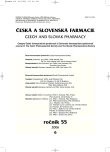Potentiometric Determination of Aqueous Dissociation Constants of 2-,3-,4-{3-(4-Benzhydryl-piperazine- -1-yl)-2-hydroxy-propoxy}-phenylcarbamic Acid Alkylesters, Water Insoluble Potential Blockers of ß-Adrenergic Receptors
Authors:
A. Lišková; M. Blešová
Authors‘ workplace:
Veterinární a farmaceutická univerzita Brno, Farmaceutická fakulta, Ústav chemických léčiv
Published in:
Čes. slov. Farm., 2006; 55, 272-277
Category:
Original Articles
Overview
Apparent ionization constants (w spKa) of potential drugs, a series of twelve protonated bases, 2-,3-,4-{3-(4- -benzhydryl-piperazine-1-yl)-2-hydroxy-propoxy}-phenylcarbamic acid alkylesters dihydrochlorides, were determined by automated potentiometric titrations in mixtures water – methanol. Aqueous pKa were assessed by means of Yasuda-Shedlovsky equation. Approach for pKa determination was evaluated using trimecaine hydrochloride as the model compound. The first values of ionization constants ranged approximately from 2.7 to 3.2, the second ones from 6.5 to 7.2. Only a slight decrease in ionization constants with the number of carbon atoms was observed in homological series. Experimentally determined dissociation constants were compared with the values predicted by the computer program SPARC.
Key words:
dissociation constant – potentiometry – mixtures water/methanol – protonated bases
Labels
Pharmacy Clinical pharmacologyArticle was published in
Czech and Slovak Pharmacy

2006 Issue 6
Most read in this issue
- Liquid Ginger Extract: Technology of Production and Quality Evaluation
- University Courses in Pharmacy in the Czech Republic
- Measurement of Adhesive Properties of Polymers in vitro
- Potentiometric Determination of Aqueous Dissociation Constants of 2-,3-,4-{3-(4-Benzhydryl-piperazine- -1-yl)-2-hydroxy-propoxy}-phenylcarbamic Acid Alkylesters, Water Insoluble Potential Blockers of ß-Adrenergic Receptors
